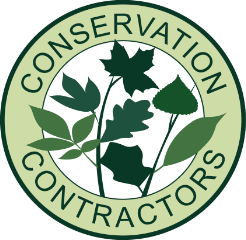
Fencing Preservatives
Fencing Preservatives
All our fencing has been treated with preservative detailed below unless it is specifically creosote treated.
Here at Conversation Contractors we use TANALISED E pressure treated timber, designed for a wide range of end uses from internal building timbers through to external timbers in ground or fresh water contact. These are classified as Use Classes 1-4 as defined in BS EN 335-1. ‘Tanalized’ timber simply refers to Tanalith E —a water based wood preservative that contains copper and proven organic biocides which has a long term protection against fungal and insect attack, including termites.
Freshly pressure treated timber has a natural greenish-yellow tint to it which blends perfectly with the outdoor environment. This colour will gradually fade away over time. After a few months the green tint will begin to disappear and leave behind a more natural looking colour, then eventually the wood will turn a silvery colour as it weathers. This weathering process does not indicate any loss of preservative protection. There’s no need to apply any extra layers of paint, wood stain or varnish to pressure treated wood — although it’s perfectly fine to paint it if you want to.
Installing your timber: Ideally timber should be cut or notched before treatment. However, where these procedures are required on-site, the surfaces exposed by the cutting or notching of TANALISED E treated timber should be further protected with end grain preservative to maintain the integrity of the preservative protection.
Prior to 2004 chromium, copper arsenate (CCA) was in widespread use (and had been since the 1940s) to prevent the decomposition of wooden timbers. This treatment consisted of chromium and arsenic salts that inhibited insect attack and microbial decay of the wood so that the lifetime of the timber is increased.
However, in June 2004 the use of CCA-treated timber was severely curtailed with an amendment of the European Union Commission Directive 76/769/EEC. This amendment states that arsenic compounds may not be used ‘in the preservation of wood. Furthermore, wood so treated may not be placed on the market’. The only exceptions are wood to be used in industrial installation that ‘the structural integrity of the wood is required for human or livestock safety and skin contact by the general public during is service life is unlikely’. The following uses are specifically not allowed (Commission Directive 2003/2/EC, 6 January 2003):
- in residential or domestic constructions, whatever the purpose,
- in any application where there is a risk of repeated skin contact
- in marine waters,
- for agricultural purposes other than for livestock fence posts and structural uses…
- in any application where treated wood may come into contact with intermediate or finished products intended for human and/or animal consumption. http://www.herinst.org/CCAtimber/regulations/Europe.html